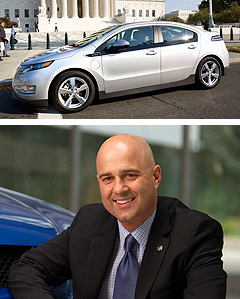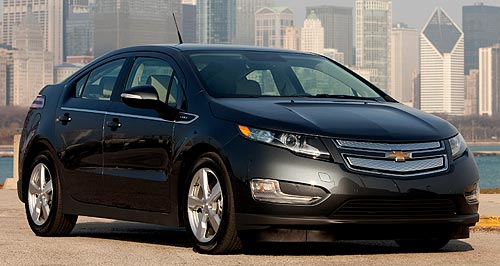Future models - Holden - VoltHolden boss says Volt will be expensiveEnergy price: With no incentives for alternative fuel vehicles from Canberra, Australian customers can expect to pay full whack for a Volt. No profit for Holden in first-generation plug-in Volt, despite hefty price tag9 Dec 2010 GM HOLDEN chairman and managing director Mike Devereux has warned that even though his company will not make any profit on the first-generation Holden Volt plug-in range-extender electric vehicle, it will be “expensive” when it lands in Australia in 2012. Despite this, Mr Devereux predicts that Holden will sell “lots” of the American-made cars that can be driven up to 60km on electricity from lithium-ion batteries before a 63kW 1.4-litre petrol engine kicks in to extend the driving range to about 480km. Pricing for the Holden version of the Volt will not be announced until launch time, but the Chevrolet variant has gone on sale in the United States for $41,000 ($A41,619) – about the same price as some European luxury cars such as the BMW 3 Series and $8000 more than the full-electric Nissan Leaf.  Left: Chevrolet Volt. Below: Holden chairman and managing director Mike Devereux. Left: Chevrolet Volt. Below: Holden chairman and managing director Mike Devereux.US federal government tax breaks can reduce that by up to $7500, cutting the price for some buyers to about $33,500 ($A34,000) – still about twice the price of a base Chevrolet Cruze. However, with no incentives for alternative fuel vehicles in the offing from Canberra, Australian customers can expect to pay full whack for a Volt, even though Holden will take no profit from it. Speaking at an American Chamber of Commerce in Australia event in Melbourne this week, Mr Devereux said the Volt had been described as a technological and engineering marvel, and that it was still being “reinvented as we speak”. But he cautioned that such technology was expensive in its early stages. “The Chevy Volt – Holden Volt in this market – will be very successful in this market, but it will be expensive,” he said. “We won’t make money on those cars for its first generation, make no mistake. We will sell a lot of Volts, but those things are expensive. “Battery technology will get much smaller, much lighter and much cheaper, and then people will get to drive them en masse.” Mr Devereux said GM believed a combination of Volt-style range-extender electric vehicles and E85 bio-fuel ethanol cars provided the best alternative fuel answers in the “near term”. “A lot of people talk about electric cars – they are the sexiest and easiest to see,” he said. “GM takes multi pronged approached, with hydrogen fuel-cell cars seen as the solution in the long term. “But we have lots of eggs in lots of baskets.” Mr Devereux indicated that the driving range of current electric vehicles (EVs) would be a problem for consumers. “You can’t really drive these pure electrics to Woodend (a Victorian town 70km from Melbourne’s CBD) and back in an electric car – you can’t,” he said. “But you can drive a Volt, easily,” Working in Holden’s favour for a reasonably priced Volt is the Australian dollar’s strong exchange rate against the USD, although 18 months is a long time in the currency market. Working against that is the high cost of shipping cars from Detroit – an issue that might ultimately convince GM to build its own version of the Volt on Cruze production lines in South Korea, China (where it is due to be launched in late 2011) and Australia. The Volt is built on the same Delta II platform as the Cruze, and such a move would help to relieve a little of the massive demand on the Detroit plant. In 2009, South Australian premier Mike Rann had talks with GM to try to convince it to build the Volt at the Holden plant at Elizabeth. The Volt has been a sell-out success in the US, where the company is already ramping up production by 50 per cent for 2012, to 45,000 units. US reports suggest that could go as high as 90,000 – three times the original figure. Giant US company General Electric alone has ordered 12,000 Volts to be delivered over five years – equivalent to three quarters of the 2011 production run of 15,000 units from GM’s Hamtramck assembly plant in Detroit. Battery supplier for the Volt, South Korea’s LG Chem, has fanned speculation that GM is set to boost Volt production even further by suggesting it expects much larger lithium battery cell orders from the American company. Vice-president of LG's car battery division Ham Jae-gyung told Reuters recently: "GM is likely to order far more batteries than we have previously planned for next year.” LG Chem has established a plant in Michigan to supply the local car industry, notably GM.  Read more2nd of August 2010  Higher-voltage production for GMVolt production to increase by half as president Obama sings Detroit praise28th of July 2010  Chev Volt plugged in for as little as $37kSharp price and lease deals announced for GM’s Volt – helped by big tax breaks5th of July 2010  Holden Volt still on target for 2012GM sets 2012 Volt production at 30,000 for global roll-out to queuing customersAll future models Alfa Romeo Alfa Romeo Abarth Abarth Audi Audi Aston Martin Aston Martin BMW BMW Bentley Bentley Chrysler Chrysler Chevrolet Chevrolet Dodge Dodge Citroen Citroen Ferrari Ferrari DS DS Ford Ford Fiat Fiat FPV FPV Foton Foton Haval Haval Great Wall Great Wall Honda Honda Holden Holden Hyundai Hyundai HSV HSV Isuzu Isuzu Infiniti Infiniti Jeep Jeep Jaguar Jaguar Lamborghini Lamborghini Kia Kia Lexus Lexus Land Rover Land Rover Mazda Mazda Maserati Maserati Mercedes-Benz Mercedes-Benz McLaren McLaren Mini Mini Nissan Nissan Mitsubishi Mitsubishi Peugeot Peugeot Opel Opel Proton Proton Porsche Porsche Renault Renault Ram Ram Saab Saab Rolls-Royce Rolls-Royce Smart Smart Skoda Skoda Subaru Subaru SsangYong SsangYong Tesla Tesla Suzuki Suzuki Toyota Toyota Volvo VolvoMotor industry news |
Click to shareHolden modelsResearch Holden All future models Alfa Romeo Alfa Romeo Abarth Abarth Audi Audi Aston Martin Aston Martin BMW BMW Bentley Bentley Chrysler Chrysler Chevrolet Chevrolet Dodge Dodge Citroen Citroen Ferrari Ferrari DS DS Ford Ford Fiat Fiat FPV FPV Foton Foton Haval Haval Great Wall Great Wall Honda Honda Holden Holden Hyundai Hyundai HSV HSV Isuzu Isuzu Infiniti Infiniti Jeep Jeep Jaguar Jaguar Lamborghini Lamborghini Kia Kia Lexus Lexus Land Rover Land Rover Mazda Mazda Maserati Maserati Mercedes-Benz Mercedes-Benz McLaren McLaren Mini Mini Nissan Nissan Mitsubishi Mitsubishi Peugeot Peugeot Opel Opel Proton Proton Porsche Porsche Renault Renault Ram Ram Saab Saab Rolls-Royce Rolls-Royce Smart Smart Skoda Skoda Subaru Subaru SsangYong SsangYong Tesla Tesla Suzuki Suzuki Toyota Toyota Volvo VolvoMotor industry news |
















Facebook Twitter Instagram